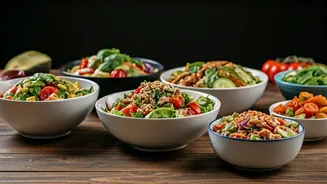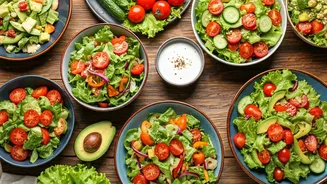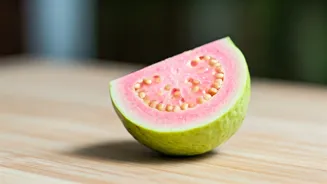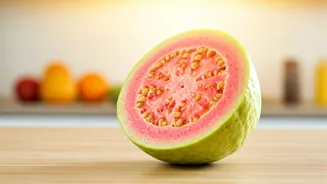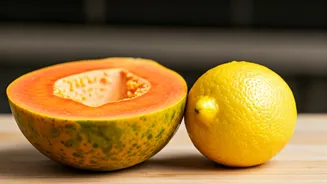Salads' Nutritional Power
Salads, often perceived as simple side dishes, are in reality nutritional powerhouses packed with essential vitamins, minerals, and fiber. The base of most
salads, consisting of leafy greens, provides a rich source of vitamins A, C, and K, along with folate and antioxidants. These components play a pivotal role in maintaining overall health, contributing to improved vision, robust immunity, and the protection of cells from damage. The fiber in salads aids digestion, promotes satiety, and helps regulate blood sugar levels. By incorporating a variety of colorful vegetables, like bell peppers, cucumbers, and tomatoes, you can enhance the nutritional value, adding a wide array of phytonutrients known for their anti-inflammatory properties. Furthermore, the inclusion of protein sources, such as grilled chicken or chickpeas, transforms salads into complete meals that provide sustained energy and support muscle health, making them a versatile and essential component of any balanced diet. Considering the nutritional benefits, salads become a convenient and delightful way to nourish the body with vital nutrients for optimal health and well-being.
Building Delicious Salads
The art of creating a delicious salad lies in the balance of textures, flavors, and nutritional content. A well-constructed salad should start with a solid base, often leafy greens like romaine lettuce, spinach, or mixed greens. Next, add a variety of colorful vegetables, incorporating ingredients like cherry tomatoes, cucumbers, bell peppers, and carrots for both visual appeal and added nutrients. Include a source of protein such as grilled chicken, tofu, or hard-boiled eggs for satiety. Consider adding healthy fats from avocados, nuts, or seeds, which provide essential fatty acids and enhance the flavor profile. The dressing plays a crucial role; opt for homemade vinaigrettes or light dressings, using olive oil and vinegar, to avoid excessive calories and unhealthy fats. To elevate the salad, include elements such as fresh herbs, which add aromatic complexity and subtle flavors. Experiment with various combinations to discover unique and satisfying flavor profiles, ensuring that the finished salad is both healthy and appealing to the taste buds. By focusing on quality ingredients and a thoughtful composition, anyone can create an enjoyable and health-boosting salad.
Exploring Recipe Options
The realm of salad recipes is vast and diverse, catering to various tastes and preferences. For instance, a classic Caesar salad presents a simple yet satisfying combination of romaine lettuce, croutons, Parmesan cheese, and Caesar dressing. Those seeking a heartier option might try a Cobb salad, which includes grilled chicken, bacon, avocado, hard-boiled eggs, and a creamy dressing. The Mediterranean salad brings the flavors of the Mediterranean with ingredients like feta cheese, olives, cucumbers, and a lemon vinaigrette. For a vibrant and colorful salad, a Southwest salad often includes corn, black beans, avocado, and a spicy dressing. Asian-inspired salads may feature ingredients like sesame-glazed tofu, shredded carrots, and a ginger-soy dressing. Vegetarian and vegan options are readily available, using ingredients such as chickpeas, lentils, and a variety of fresh vegetables. Each recipe can be customized, allowing the substitution or addition of ingredients to accommodate dietary needs or taste preferences. The key is to experiment with different flavor combinations to find the salads that one personally enjoys the most, turning healthy eating into a pleasurable experience.
Ingredient Selection Matters
The freshness and quality of ingredients significantly influence the taste and nutritional value of a salad. Opt for locally sourced, seasonal produce to maximize flavor and nutritional content. When selecting leafy greens, look for vibrant, crisp leaves without any signs of wilting or discoloration. Choose ripe, firm vegetables that are free from bruises or blemishes. Consider the source of protein additions; opt for lean meats, such as grilled chicken or fish, and plant-based protein sources like chickpeas, lentils, or tofu. Select nuts and seeds that are fresh and free from rancidity, and store them properly to maintain their flavor and texture. For dressings, consider using high-quality olive oil and fresh herbs to create a lighter and healthier alternative to commercially prepared dressings. Preparing ingredients such as roasting vegetables or grilling protein in advance saves time and allows for convenient salad preparation. By focusing on fresh, high-quality ingredients, you can make a salad that is both delicious and packed with the nutrients the body needs for good health.
Dressing and Flavor Enhancers
The right dressing can elevate a salad from ordinary to extraordinary, serving as a vital component in determining its overall flavor profile. Homemade dressings offer more control over ingredients and enable customization to suit individual tastes. A simple vinaigrette made with olive oil, vinegar, and herbs forms the base for many salads, allowing for modifications by adding various spices and flavorings. Experiment with ingredients such as lemon juice, Dijon mustard, honey, and garlic to add complexity and depth to the dressing. For a creamier dressing, consider using Greek yogurt, avocado, or tahini as a base. Avoid excessive amounts of sugar, salt, and unhealthy fats found in commercial dressings. In addition to dressings, various flavor enhancers can be included. Fresh herbs, such as basil, parsley, and cilantro, add freshness and brightness. Toasted nuts and seeds provide texture and nutty notes, while crumbled cheese offers salty and creamy elements. Consider adding fruits like berries or citrus segments to bring natural sweetness and visual appeal. The ability to control both the ingredients and flavorings ensures a delicious and nutritious eating experience.
Salad Preparation Techniques
Effective salad preparation involves several techniques to optimize the flavor, texture, and overall enjoyment of the dish. Washing all vegetables and greens thoroughly is the initial step, ensuring the removal of dirt and debris. Use a salad spinner or paper towels to dry the greens after washing, as excess moisture dilutes the dressing and impacts the texture. Chop or slice vegetables uniformly, which ensures an even distribution of flavor and texture. Prepping ingredients in advance, such as roasting vegetables or cooking proteins, simplifies the assembly process and saves time. Assemble the salad just before serving to prevent the greens from becoming soggy. If preparing the salad ahead of time, store the dressing separately and add it just before consumption. Experiment with different knife techniques and cutting styles to achieve the desired presentation. Consider using a variety of shapes and sizes when cutting ingredients, and incorporate elements like sprouts, microgreens, and edible flowers to enhance visual appeal. The attention to detail in the preparation process transforms a salad from a simple dish to an artful and pleasurable culinary experience.
Customizing for Preferences
Salad recipes are highly adaptable, offering ample opportunities for customization to cater to various taste preferences and dietary needs. If you enjoy spicy flavors, consider adding chili peppers, jalapeños, or a dash of hot sauce to the dressing. For those seeking a sweet element, dried fruits, honey, or maple syrup can be incorporated. Protein additions like grilled tofu, beans, or quinoa can make a salad more filling and balanced for vegetarians and vegans. Individuals with nut allergies can substitute seeds such as sunflower or pumpkin seeds. The choice of greens can be customized; spinach, kale, and romaine lettuce all bring unique flavor and texture. Experimenting with different flavor combinations is essential to discovering what works best for your palate. Whether you prefer a lighter, simpler salad or a more complex and flavorful one, customizing the recipe to meet individual preferences ensures enjoyment. Embrace culinary creativity and explore the numerous possibilities to personalize each salad to perfection.
Salads for Weight Management
Salads can play a significant role in weight management due to their low-calorie density, high fiber content, and ability to promote satiety. The fiber in salads helps regulate blood sugar levels, preventing the energy crashes that can contribute to overeating. Salads comprised of leafy greens and non-starchy vegetables offer ample volume with minimal calories, which aids in feeling full with fewer calories consumed. The addition of lean protein sources, such as grilled chicken or fish, sustains energy levels and reduces the likelihood of overeating later in the day. Be mindful of the dressings and toppings, choosing lighter options like vinaigrettes over creamy dressings. Controlled portion sizes and proper ingredient selection are vital for maintaining a healthy calorie balance. Salads can serve as a meal replacement or part of a balanced diet, facilitating weight loss. By prioritizing nutrient-rich ingredients and controlling portion sizes, salads provide a satisfying and health-conscious option for weight management efforts.
Salads for Special Diets
Salads are incredibly versatile and can be adapted to accommodate a variety of special diets, including vegetarian, vegan, gluten-free, and paleo. For vegetarians, salads can be built around a range of plant-based protein sources, like chickpeas, lentils, tofu, and beans. Vegans can create equally satisfying salads by substituting animal products with plant-based alternatives. Gluten-free salads are straightforward, avoiding ingredients such as croutons and using gluten-free dressings. Paleo salads embrace ingredients such as lean proteins, fresh vegetables, and healthy fats, while excluding grains, legumes, and processed foods. The flexibility of salad recipes allows the incorporation of ingredients that fit within any dietary framework. By substituting ingredients appropriately, individuals can create nutritious and flavorful meals that align with their dietary restrictions and preferences. Careful consideration of ingredient choices ensures that salads can be enjoyed by individuals with diverse dietary needs.
Salad Storage and Safety
Proper storage and food safety practices are crucial to ensure the quality and safety of salads. Store prepped salad ingredients separately, such as washing and chopping greens and vegetables in advance, and storing them in airtight containers in the refrigerator. Assemble the salad just before serving to avoid sogginess. If preparing the salad ahead, store the dressing separately and add it right before eating. When using perishable ingredients such as meat or dairy products, ensure they are stored at the correct temperatures to prevent bacterial growth. Always wash your hands and any utensils and surfaces that come into contact with the food before starting and throughout the preparation process. Discard any salad ingredients that show signs of spoilage, such as wilting, discoloration, or an off odor. If taking salads to go, use insulated containers and keep them chilled until consumption. These precautions will help preserve the freshness, flavor, and safety of salads, ensuring a healthy and enjoyable meal experience.
Salad Meal Planning Tips
Effective meal planning is an excellent strategy to incorporate salads into a healthy diet. Plan the week's meals in advance, noting salad components. Create a grocery list based on your salad recipes, focusing on fresh produce, proteins, and dressings. Wash and prep vegetables and other ingredients in advance; storing them in separate containers simplifies the assembly process. Prepare extra protein, like grilled chicken or chickpeas, for easy use throughout the week. Vary salad components to avoid monotony and ensure a balanced intake of nutrients. Consider incorporating different types of salads each day. When packing salads for work or school, use portable containers to keep ingredients separated and fresh. Having pre-portioned ingredients at the ready saves time and promotes healthier eating habits. Planning also reduces food waste. By implementing these meal planning strategies, incorporating salads into your daily routine is streamlined. This enhances the likelihood of eating nutritious and delicious meals consistently.
Beyond the Basics
Expanding your salad horizons involves exploring diverse ingredients and incorporating creative techniques. Try using different types of greens, like arugula or radicchio, to add unique flavors and textures. Experiment with adding fruits like pomegranate seeds or orange segments for sweetness and vibrant color. Introduce roasted vegetables, such as sweet potatoes or Brussels sprouts, to create depth and warmth. Consider including nuts, seeds, and grains. Explore global cuisines for salad inspiration. Experiment with unusual dressing ingredients, such as miso paste or tahini, to add complexity. Learn to make homemade croutons or flatbreads for texture and flavor. The more you explore, the more you will unlock culinary freedom. By being open to innovation and experimenting with new flavors and textures, you can transform the way you think about salads. Make them a regular source of delicious and nutritious eating.
Salad Dressing Secrets
Mastering salad dressing involves more than simply mixing ingredients; it requires an understanding of balance and flavor. Start with a base, typically olive oil, for its healthy fats and taste. Then, add an acid, such as vinegar or citrus juice, for brightness. Add seasonings to create depth, like salt, pepper, herbs, and spices. A touch of sweetness, from honey or maple syrup, can balance the acidity. Emulsification is key to a consistent texture. Whisking vigorously or using a blender helps combine oil and vinegar. For creamier dressings, consider adding ingredients like yogurt or avocado. Experiment with different types of oil and vinegar to discover your preferred flavor combinations. Homemade dressings allow control over the quality of ingredients and can be customized to personal preferences. The secret to great dressing lies in the balance of flavors and the quality of the components. Practice, and your salads will be elevated. The ability to create your own dressing elevates the whole culinary experience.
Salad for Every Season
Seasonal eating enhances the enjoyment of salads. In spring, embrace fresh, tender greens, asparagus, and snap peas. Summer offers a bounty of tomatoes, cucumbers, and corn. Fall brings hearty ingredients like squash, apples, and root vegetables. Winter is the time for citrus fruits, like oranges and grapefruits. Changing the salad's focus with the season ensures flavor diversity. Utilize seasonal produce at its peak ripeness. This will result in the most delicious and nutritious salads. Consider the weather when planning salads, favoring lighter options in warmer months and heartier ones when it's colder. Supporting local farms and markets is easy when using seasonal produce. Seasonal eating is a sustainable practice. Planning a varied diet is achieved. This helps maintain interest in salads. The ability to make salads that are perfectly suited to the weather improves overall enjoyment.
Salads for Social Gatherings
Salads are ideal for social gatherings. They can be prepared in advance. Their versatility suits various events, such as potlucks or picnics. Offer multiple salads at parties to accommodate different tastes and dietary needs. Provide both vegetarian and meat-based options. Consider creating a salad bar. Offer a variety of ingredients, from greens to toppings, so people can customize their salads. This creates a fun and interactive experience. Choose salads that are easy to transport, like pasta salads or grain bowls, for outdoor events. Garnish salads beautifully to enhance their presentation. Label ingredients clearly to inform guests of allergens or special ingredients. Salads are easy and fun to share. Use them to make social events healthier. They can transform get-togethers into both enjoyable and healthful gatherings for all.


